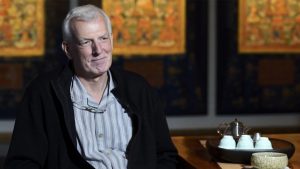The recording of the livestream is available here: https://www.youtube.com/watch?v=xjr3sEC14y0
Please join us in in Room 120, CK Choi Building (1855 West Mall) on Thursday, February 9 at 5:30 pm PST. To ensure that our event abides by the current provincial health guidelines at the time, please register here: https://bit.ly/TibetanArtMara

The Daughter’s of Mara refers to the three principal difficulties that all students and scholars appear to have when first studying and later teaching Tibetan art. This applies to both an introductory and advanced level. The root of the problem is structurally Western academia but that won’t be the focus of this presentation. With any new endeavour undertaken, understanding at the outset the pitfalls and dangers will go a long way to mitigating any obstacles or failures that might be encountered. Recognizing the Three Daughter’s of Mara is that first step in the study of Tibetan art.
Jeff Watt is one of t he leading scholars of Himalayan art and Executive Director of Himalayan Art Resources, a digital collection of some of the world’s most important works of art from the varying cultures of the Himalayan regions. He had several teachers such as the 3rd Dezhung Rinpoche (Seattle Wa) and the 41st Sakya Trizin (Dehradun, India). He took monastic vows at age 17 from the 16th Gyalwa Karmapa. For 11 years Jeff trained intensively in India, Canada, and the US with multiple teachers. In 1985 he gave back the monastic vows and continued to study and translate sacred Tibetan and Sanskrit texts. Jeff has continued with his own traditional retreats and periodic practices between his homes in British Columbia and New York.
he leading scholars of Himalayan art and Executive Director of Himalayan Art Resources, a digital collection of some of the world’s most important works of art from the varying cultures of the Himalayan regions. He had several teachers such as the 3rd Dezhung Rinpoche (Seattle Wa) and the 41st Sakya Trizin (Dehradun, India). He took monastic vows at age 17 from the 16th Gyalwa Karmapa. For 11 years Jeff trained intensively in India, Canada, and the US with multiple teachers. In 1985 he gave back the monastic vows and continued to study and translate sacred Tibetan and Sanskrit texts. Jeff has continued with his own traditional retreats and periodic practices between his homes in British Columbia and New York.